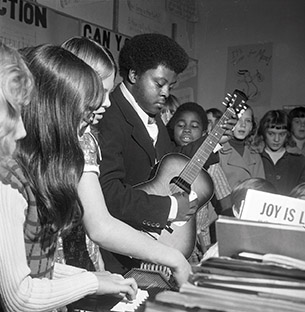Determined entrepreneur-turned-photographer Orlando Wootten’s documentation of Delmarva captured the essence of its people and pastimes
Written by Ian Post
While photographs document ephemeral moments throughout time, they rarely capture the timeless traditions of people using the land and water — and the eternal beauty of their environment. In the mid-20th century, an ice cream man in Salisbury used professional photography techniques and his artistic eye to develop a portfolio that immortalizes this timeframe on Delmarva. Through Orlando Wootten’s photograph collection at the Nabb Research Center, now available online, we can simultaneously understand our unique regional traditions and appreciate the aesthetic of the images in which they’re captured.
Born in Laurel, DE, in 1909, Orlando Wootten’s early life changed at age 15, when his father — a small-farm operator who also built and ran several sailing vessels — died. Among his final wishes, he directed his bank to provide Orlando with a “fine education.” Wootten later attended Harvard University, where he studied English composition and literature, as well as Columbia Teachers College, where he received an MA in education. After several failed lumbering, farming and butchering ventures during the Great Depression, Wootten was commissioned in the U.S. Coast Guard during the Second World War.
After the war, Wootten moved to Salisbury, where he started an ice cream wholesaling business. One of his young employees, who helped freeze and package 400 gallons of ice cream, was Paul Sarbanes, the late U.S. senator from Maryland. When his family doctor recommended that Wootten find a hobby, he bought a camera and learned the art of photography. Later, in the mid-1960s, the city condemned and demolished his ice cream business — an unfortunate moment that nevertheless launched his career as a professional photographer.






Between 1950 and 1983, Wootten honed his photographic eye by attending institutes of photography in Vermont, New York City and London. During this time, he worked as a staff photographer for the National Park Service, wrote freelance pieces for the Associated Press and served as a photojournalist for The Daily Times in Salisbury. Wootten’s career in photography on the Delmarva Peninsula provided him with the means to document the artistic elements of the place he called home.
Wootten’s photographs don’t capture the people and the environment separately; instead, they’re composed such that they demonstrate how people have made livelihoods and traditions on Delmarva’s land and water. In these photographs, we see folks who farm, hunt and trap on land; sail, fish and dredge the water; and sing, eat and celebrate in our communities. The demonstration of long-held traditions are shown in harmony with the eternal landscape of the Chesapeake region — oftentimes captured in a single Wootten photograph.
Wootten’s archival collection came to the Nabb Research Center at Salisbury University in 1995, just two years before he passed away. His photography first garnered widespread recognition in the halls of TidalHealth’s Peninsula Regional Medical Center, but his legacy was cemented in books about the Chesapeake Bay and with the 1994 book Wootten’s Delmarva: A Glimpse of Eastern Shore Life Through the Photographer’s Eye. Now, for the first time ever, Wootten’s collection of 5,500 negatives, slides and prints are available online: https://flic.kr/s/aHsmRha5Xg. For questions about purchasing Wootten’s Delmarva or acquiring reproductions, email nabbcenter@salisbury.edu.
Editor’s note: Ian Post is the Local History Archivist (formerly University Archivist and Special Collections Librarian) at the Nabb Research Center at Salisbury University. Originally from Michigan, he earned his MSLIS from the Pratt Institute School of Information. He has worked in several archives in Western Michigan, New York City and Maryland.

Enjoyed this article and especially the picture of my Grandmother with her favorite Billy Goat !!! Her name was Ida Truitt, who lived near Pocomoke City Maryland. The Goat’s name was Billy who was trained to pull the cultivator and to pull the grandchildren in a cart.